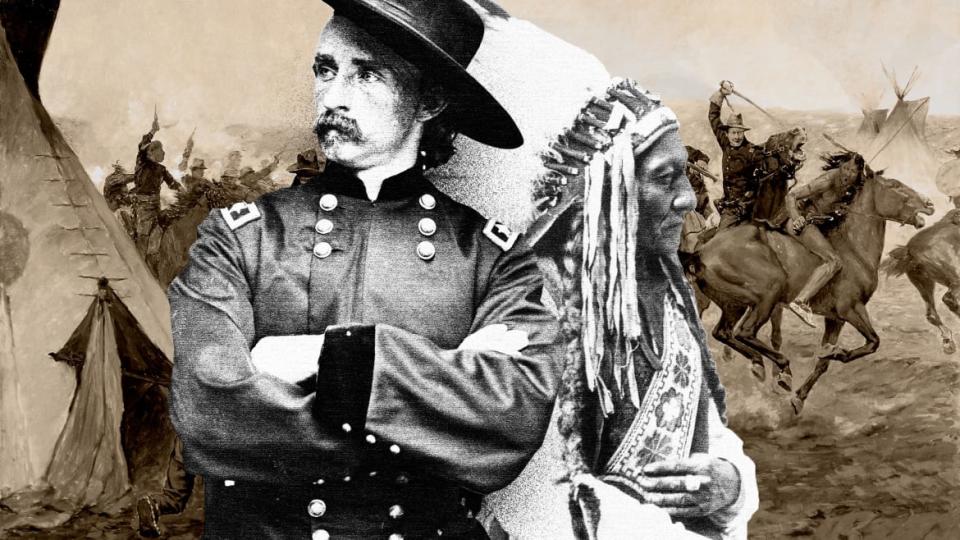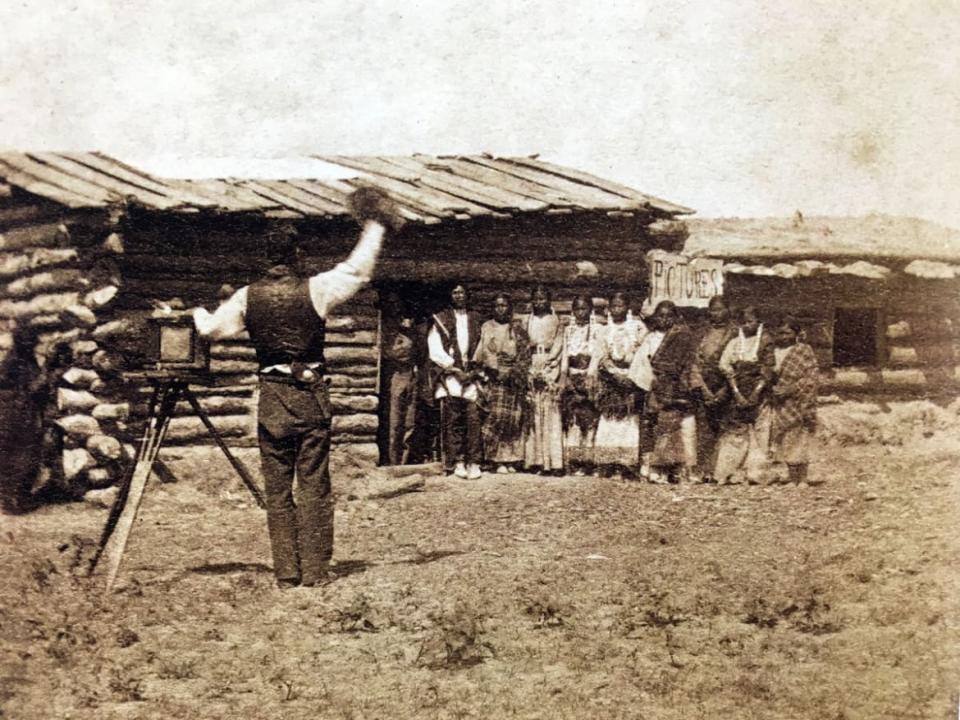Custer Lost but No One Really Won at the Little Big Horn

On June 25, 1876, a village of some five thousand Lakotas and Cheyennes camped on the Greasy Grass River (today’s Little Big Horn) was famously attacked by George Armstrong Custer and his vaunted Seventh Cavalry. The Indians were followers of the powerful Húnkpapa holy man Sitting Bull, and, like their leader, most of them wanted nothing to do with white men. They simply wanted to be left alone, to live separate from the Euro-Americans who’d been steadily encroaching and trespassing upon Lakota lands for decades.
With shouts of “Hóka hé!” (Come on!) and “The Earth is all that lasts!” the Oglala war chief Crazy Horse and other Indian leaders rapidly gathered their warriors and galloped off to defend their families. And because Custer had unwisely divided his regiment into three battalions, more than a thousand Lakota and Cheyenne fighting men were able to strike these separated detachments individually. On a grassy ridge overlooking the Greasy Grass, the warriors completely overwhelmed Custer and some two hundred troopers of the Seventh. The Indians’ stunning victory was soon dubbed “Custer’s Last Stand.”
“The people in the States blame me for having killed Custer and his army,” Sitting Bull said in 1878. “He came to attack me, and in sufficient numbers to show me that they wanted to destroy me and my children.”
The Army’s disaster on the Greasy Grass served only to intensify the U. S. government’s efforts to force Sitting Bull’s and Crazy Horse’s people upon reservations—or be exterminated. Less than a year later, and facing starvation, Crazy Horse and his band surrendered near Camp Robinson, Nebraska. But the transition to reservation life was difficult, especially for the great war chief Crazy Horse. So leery was he of being manipulated into trading away his peoples’ lands that he initially refused to receive his band’s annuity goods. Too many chiefs had “touched the pen,” with the Lakota homeland diminishing each time.
Larry McMurtry on the Villainous Custer and the Myths of the West
Just four months after his surrender, a false rumor that Crazy Horse was plotting to assassinate General George Crook at an upcoming council meeting led to a botched arrest attempt. On September 5, 1877, the 34-year-old war chief was bayonetted in a struggle outside the Camp Robinson guardhouse. Crazy Horse’s holy man had told him a bullet would never kill him, and a bullet never did.
Sitting Bull had fled to Canada with his people early in 1877 and remained there for four years, until the prospect of starvation also forced him to return to the United States with his followers and surrender. After twenty months as “prisoners of war,” they were located on the Standing Rock reservation, where Sitting Bull soon made an enemy of the Indian agent, James McLaughlin, by resisting many of his efforts to “civilize” them. Sitting Bull wasn’t against educating his people, but he wanted the children taught to read and write in Lakota. Indian Bureau policy, however, prohibited government and missionary schools from teaching students to read and write in their native language. The Bureau wanted those “barbarous dialects,” along with all remnants of their traditional culture, stamped out.

The log cabin studio that was next to the post trader’s store at Camp Robinson, Nebraska
When Sitting Bull accepted an offer to be a part of Buffalo Bill Cody’s Wild West exhibition for the 1885 season, his primary reason for going was a chance to speak with the “Great Father,” President Grover Cleveland. Sitting Bull told a reporter that he had “nothing but justice to ask” of Cleveland. He hoped the Great Father would grant him a section of broad prairie where his village would be safe and the white man wouldn’t bother them, where he could die in peace. What he got instead was a simple handshake.
In the winter of 1890, the powerful Ghost Dance religion swept across Sioux country. Adherents believed that by performing the specific dance, the buffalo would return, along with their dead families and friends, and whites would be sent away from Indian lands. Sitting Bull again defied the Indian Bureau by refusing to order his people to stop dancing. In a dictated letter to Agent McLaughlin, Sitting Bull said he didn’t look down upon the way the agent prayed, so why did the agent question the way his people prayed? To McLaughlin, though, the Ghost Dance was a step back to paganism and Sitting Bull nothing but a troublemaking “nonprogressive.”
When word reached McLaughlin that Sitting Bull was planning to leave Standing Rock to visit the Ghost Dancers at Pine Ridge, he ordered his “Metal Breasts” (Indian police) to arrest the holy man and chief. Tragically, the December 15 arrest attempt devolved into a melee between Sitting Bull’s followers and the police, with Sitting Bull being shot and killed outside his cabin. McLaughlin subsequently wrote his superiors in Washington that the ending of Sitting Bull’s career was “most gratifying.”
But the deaths of the great Lakota leaders Crazy Horse and Sitting Bull were not the end of Lakota resistance, not by any means. And over the decades since, Crazy Horse and Sitting Bull have often served as inspiration for those fighting for change and justice for the Lakotas and other native peoples, from the American Indian Movement (AIM) takeover of Wounded Knee in 1973 to the Dakota Access Pipeline protests of a few years ago.
And a long-needed reexamination and reset of the way most Americans (and many historians and authors) have viewed the past from anything but an Indigenous perspective has resulted in a number of positive changes, if mostly symbolic. In 1991, the former Custer Battlefield National Monument was renamed Little Bighorn Battlefield National Monument, and an Indian Memorial, recognizing all Indians who participated in the iconic fight, was dedicated at the park 12 years later. In the Black Hills, the highest peak had gone by the name of an Army general best known for his brutal attack on a Lakota village in 1855. The name was changed to Black Elk Peak in 2016 in honor of the famed Lakota holy man, Nicholas Black Elk (1863-1950). Today, under the direction of Secretary of the Interior Deb Haaland, the first Indigenous person to serve in a cabinet position, a process is underway to replace derogatory names of geographic features on federal lands, many of which, sadly, are pejorative references to Indians.

Sculptor Korczak Ziolkowski with a model for his proposed carving of Crazy Horse on Thunderhead Mountain, June 1948
Perhaps the greatest victory for the Lakotas since the Little Big Horn, however, occurred in the chambers of the U. S. Supreme Court in 1980. In United States v. Sioux Nation of Indians, the court affirmed that the Black Hills had been wrongfully taken and awarded a settlement to the Lakotas that has now, with interest, reached nearly $2 billion. It’s reached that figure because the Lakotas refuse to accept the payment and thus relinquish their claims to the Hills and its resources, which they hold sacred. That stand, a forerunner of the present Land Back movement, echoes the policies of Crazy Horse and Sitting Bull, who violently opposed ceding any of their homeland to the U. S. government.
What the eventual outcome will be is anyone’s guess, but the spirits of Crazy Horse and Sitting Bull are ever present. As one Lakota man said some years ago regarding the effort to return the Black Hills to his people, “We won the battle against Custer, but the war continues.”
Mark Lee Gardner is the author of The Earth Is All That Lasts: Crazy Horse, Sitting Bull and the Last Stand of the Great Sioux Nation, Rough Riders, To Hell on a Fast Horse and Shot All to Hell, which received multiple awards, including a Spur Award from Western Writers of America. An authority on the American West, Gardner has appeared on PBS’s American Experience, as well as on the History Channel, AMC, the Travel Channel, and on NPR. He has written for National Geographic History, American Heritage, the Los Angeles Times, True West, and American Cowboy. He holds an MA in American Studies from the University of Wyoming and lives with his family at the foot of Pikes Peak.
Get the Daily Beast's biggest scoops and scandals delivered right to your inbox. Sign up now.
Stay informed and gain unlimited access to the Daily Beast's unmatched reporting. Subscribe now.

 Yahoo Movies
Yahoo Movies 